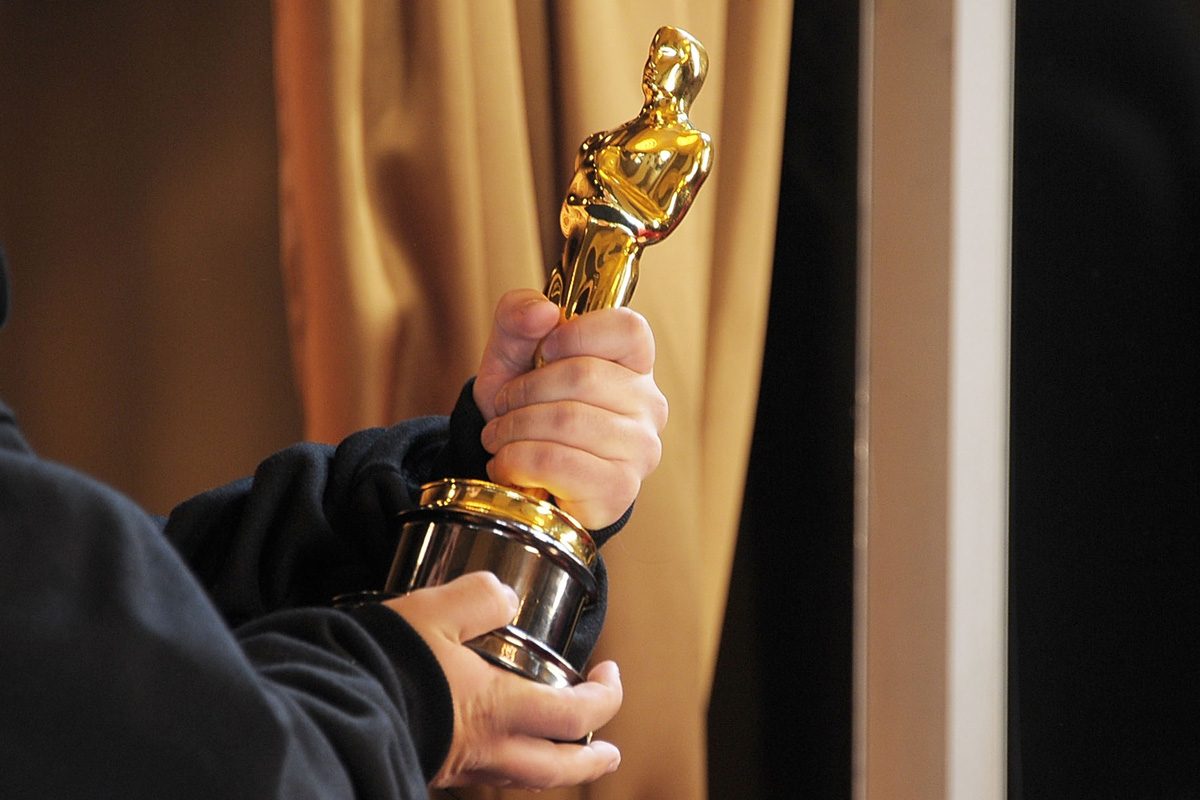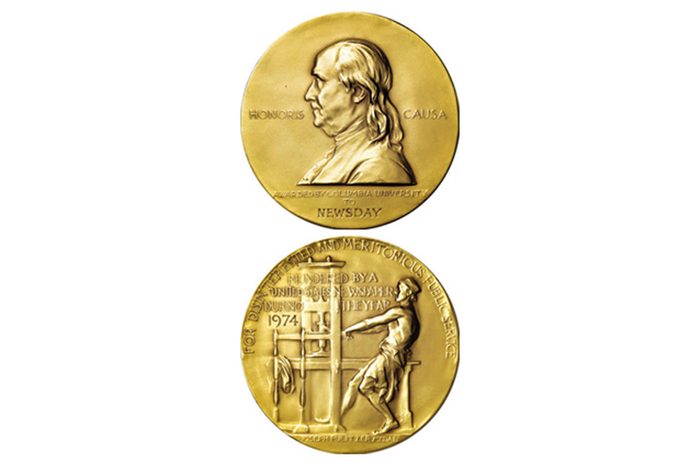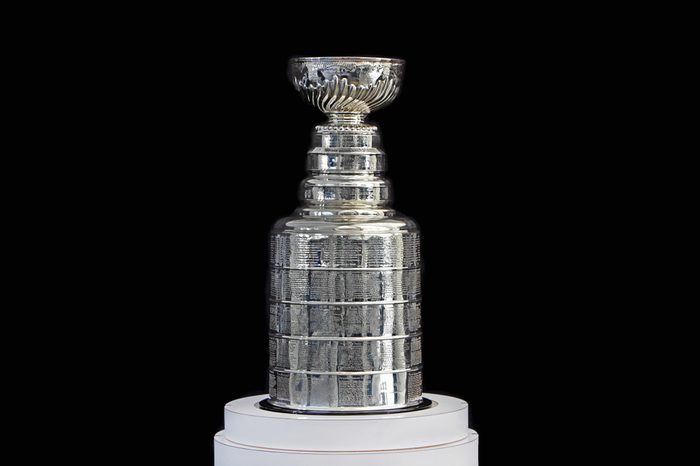Take a closer look at the coveted golden guys, gals, globes and gramophones that contenders are clearing shelf space for. How many of these award show trophy facts did you know?

11 Award Show Trophy Facts You’ve Never Heard Before


The Academy Award
Height: 13.5 inches
Weight: 8.5 pounds
Likely the most recognized trophy in the world, Hollywood’s highest honor, also called the Oscar, was first handed out in 1929. Originally conceived as a labor-relations entity, the Academy of Motion Pictures Arts and Sciences was the brainchild of Louis B. Mayer, the head of Metro-Goldwyn Mayer (MGM). Envisioned as a golden knight standing on a film reel and gripping a crusader’s sword, the iconic statuette was designed by MGM art director Cedric Gibbons and sculpted by George Stanley.
The reel has five spokes, one for each of the five original Academy branches: actors, directors, producers, technicians and writers. The origin of his widely used nickname is unknown, although one popular explanation is that Academy librarian (and later executive director) Margaret Herrick exclaimed upon first seeing the heavy metal hunk that he reminded her of her uncle Oscar.
It takes the Polich Tallix Fine Art Foundry in Walden, New York, three months to make 50 solid bronze statuettes and plate them in 24-karat gold. More than 3,140 of them have been given out since the first Academy Awards. Not even World War II stopped Hollywood’s biggest night from happening, although recipients received painted plaster tokens for three years, thanks to the metal shortage. Once the fighting finished, the Academy allowed the placeholder prizes to be exchanged for the real thing.

The Emmy
Height: 15 inches
Weight: 6 pounds, 12 ounces
The 48th time was the charm in the case of TV’s top trophy, which honors the best of the small screen. After tossing aside 47 proposals in 1949, the Academy of Television Arts and Sciences selected a design featuring a winged woman holding an atom submitted by television engineer Louis McManus. (His wife was the model.) The wings represent the muse of art, and the atom symbolizes the scientific side of the industry.
“Immy,” as she was originally known, was named after the image orthicon camera, which was commonly used at the time. Another suggestion was “Ike,” the moniker for the iconoscope (an earlier tube camera), but members didn’t want it to be mistakenly associated with Dwight D. Eisenhower. Immy soon became Emmy because members at the time thought the name was fitting for the statue’s feminine figure.
Chicago’s R.S. Owens & Co. combines copper, nickel, silver and gold to make nearly 400 trophies each year. Each Emmy takes five and a half hours to make, and must be handled with white gloves to prevent fingerprints.

The Grammy
Height: 9.5 inches
Weight: 5 pounds
Music’s biggest night was originally called the Gramophone Awards when the first ceremony was held in 1959, which explains why the shelves of artists like Beyoncé, Adele, Paul McCartney and Taylor Swift are lined with gilded gramophones.
The original Grammy, featuring a soldered hand crank and a walnut base, was created in 1958 by the Recording Academy‘s original craftsman, Bob Graves. In 1963, Graves made the crank static after too many enthusiastic recipients accidentally broke it off. After Graves died in 1986, longtime apprentice John Billings took over and modified the statue once again in 1991. He got rid of the crank altogether, changed the base to black (though Latin Grammys have burgundy bases) and made it 30% larger. Grammys are plated in 24-karat gold.
Billings and his Ridgway, Colorado, crew make Grammys all year long. Between 300 and 350 Grammys are awarded annually, and each one takes 15 hours to produce.

The Tony
Height: 5 inches
Weight: 3.5 pounds
Broadway’s best and brightest gather every June to put their jazz hands together for the musicals, plays and players that dominated the stage that season. Given out by the American Theatre Wing (ATW) and the Broadway League, the Antoinette Perry Award for Excellence in Broadway Theatre was named for the co-founder of the ATW. When the Tonys were first awarded in 1947, winners were given scrolls, and according to the New York Times, men also received a money clip, while women got a compact.
Two years later, the prize, designed by Herman Rosse, became a medallion in a presentation case. In 1967, when the ceremony was first televised, the medallion, which featured comedy and tragedy masks on one side and a profile of Antoinette Perry on the other, was connected to a curved armature and mounted to a black pedestal. In 2010, the trophy grew almost 2 inches taller and 2 pounds heavier because its small stature was awkward for winners to grip. The namesake’s picture was also removed, to make way for winner details to be etched on that side instead.

The Golden Globe
Height: 11.5 inches
Weight: 7.8 pounds
The entertainment industry rings in the new year at the Beverly Hilton Hotel with this January awards show honoring the top TV series, movies and the people who make them. The awards, which are given out by the Hollywood Foreign Press Association, started in 1944, and the show is decidedly less stuffy than other offerings. The Golden Globes reward winners with the most on-the-nose trophy: It’s gold (plated), topped by a globe and surrounded by a strip of film.
In 2019, the previous base, which was marble, was replaced with a cylindrical metal one. It is also 2.3 pounds heavier and 3/4 of an inch taller than the previous prize, according to the Hollywood Reporter. The youngest person to nab a globe was 9-year-old Ricky Schroder in 1980 for The Champ, while the oldest victor was 87-year-old composer Ennio Morricone, whose Hateful Eight music nabbed Best Original Score in 2016.

The Actor
Height: 16 inches
Weight: 12 pounds
For its annual acting awards show, which began in 1995, the Screen Actors Guild (SAG) appropriately bestows the beautiful people with an incredibly tall, fit statuette who holds the comedy and tragedy masks of yore in his outstretched arms. Like Oscar, he’s not wearing any clothes. According to SAG, the Actor’s career began when he was sculpted by Edward Saenz and designed by Jim Heimann and Jim Barnett.
It takes a team of 10 skilled crafters at the American Fine Arts Foundry in Burbank, California, three to four months to produce the lot using what’s called the “lost wax method,” where wax is encased in a mold and then melted out. The mold is then filled with hot metal. The arms are attached separately. The final bronze version weighs 10 times what the wax one does, and that’s before the base is added. Each final product is stamped with a unique serial number. Because they don’t know exactly which TV programs or films will take home the cast awards, which have variable numbers of winners, they have extras made every year and any surplus nudes are stored in a secret SAG vault until the next year.

Film Independent Spirit Award
Height: 12 inches
Weight: 6 pounds
Since 1986, the Independent Spirit Awards have celebrated the best of independent cinema with an avian-inspired award designed by artist Carol Bosselman. An abstract bronze bird is perched atop a pedestal wrapped with a single shoelace, which according to Film Independent, symbolizes the shoestring budgets most of the contenders were shot on. (Film Independent produces the awards and puts on the party often billed as the anti-Oscars.) The trophies are made by hand by American Fine Arts Foundry using the lost wax casting method. Giving it a patina through a combination of heat and chemicals is the last step in the process. Over the years, the Independent Spirit Awards have honored a wide range of films, from inventive comedies to some of the best dramas of all time, proving that creativity often thrives outside the mainstream.

The ESPY
Height: 17 inches
Weight: 6.17 pounds
First handed out in 1993, the ESPYs recognize individual and team athletic achievements as well as coaching prowess across the wide world of sports. The name stands for Excellence in Sports Performance Yearly, according to ESPN, which coincidentally is the network that doles out the ESPY awards. (The show now airs live on ABC and streams on ESPN sister channels.)
The trophy, a long silvery base topped with a basketball-like sphere, was the brainchild of late sculptor Lawrence Nowlan, who also designed the prize for the short-lived My VH1 Music Awards (held in 2000 and 2001). The artist’s other work includes the Wildland Firefighters National Monument in Boise, Idaho, and the statue of Jackie Gleason as his Honeymooners character Ralph Kramden inside the Port Authority Bus Terminal in Manhattan.
Golfer Tiger Woods still holds the record for most individual ESPY wins (21), a title he stole from Michael Jordan with his 11th win back in 2001.

Heisman Trophy
Height: 13.5 inches
Weight: 25 pounds
The Heisman Trophy has been bestowed on college football’s best player, as chosen by New York’s Downtown Athletic Club (NYDAC), since 1935. That year, the trophy, which was called the Downtown Athletic Club Trophy until the following year, went to University of Chicago running back Jay Berwanger, whose aunt Gussie used it as a doorstop. Since 2005, the heavy hardware has been sculpted by MTM Recognition in Oklahoma. Coincidentally, the Oklahoma Sooners have seven Heisman wins, tied with Ohio State and Notre Dame, and are the only team to have back-to-back winners from the same position: quarterbacks Baker Mayfield and Kyler Murray.
The statue’s namesake, John Heisman, played for Brown University and the University of Pennsylvania in the late 1800s before coaching at schools including Auburn, Clemson, Rice and Georgia Tech. He is credited with inventing the center snap and legalizing the forward pass. He was the NYDAC athletic director when the inaugural award was handed out, and when he died the following year, the club voted to rechristen the award in his honor.
But the iconic pose? Not his. As a lineman, he rarely had the ball in his hands. It was based on the moves of Ed Smith, a former New York University running back who modeled for the sculptor Frank Eliscu in 1934. He had no idea his pal had put him on that primo pedestal until a documentary filmmaker contacted him for an interview in 1982.

Pulitzer Prize Gold Medal
Height: 1/4 inch when laid flat
Weight: unavailable
The Pulitzer Prize is the premier award for journalism, arts and letters. For the majority of Pulitzer categories, the winners receive a certificate, $15,000 and bragging rights. Only one category, Public Service, comes with a physical medal, and an individual can’t win it. The American newspaper that takes the top spot collects a 24-karat-gold-plated silver medallion presented in a cherry wood box.
The award was designed in 1918, a year after the competition was launched, by sculptor Daniel Chester French, who went on to carve Abraham Lincoln for the Lincoln Memorial in Washington, D.C., and his partner, Henry Augustus Lukeman. It features a bust of Benjamin Franklin, who himself was a successful editor and publisher of periodicals in the 1700s. A brawny bare-chested printer at a printing press is on the flip side. Surrounding the worker are the words “For disinterested and meritorious public service rendered by an American newspaper during the year …” The year of the award is inscribed on that side, while the winning institution’s name is etched under Franklin.

Stanley Cup
Height: 35.25 inches
Weight: 34.5 pounds
This famous trophy is older than the National Hockey League itself, as the decorative bowl was first donated by Lord Stanley of Preston in 1893. Stanley was the Governor General of Canada at the time, and he became obsessed with hockey after seeing it at Montreal’s 1889 Winter Carnival. The award was to be given to Canada’s top amateur club (pro teams became eligible in 1906) and passed around to each winning team. The original cup was retired to a display case at the Hockey Hall of Fame in Toronto in 1963, as it became too brittle, and the “Presentation Cup” took its place.
The championship team’s roster is etched by the NHL’s official engraver onto a band on the same trophy each year (instead of a new cup being minted), which is unique to sports and awards in general. Only two teams are found within the bowl’s inner wall. Since 1958, there have been five bands of champions. When one fills up, they remove the oldest ring and move it to the vault with the original cup. Then, a new blank one is added. Two rings don’t have names because the Cup was not awarded in 1919 (due to a Spanish Flu outbreak) or from 2004 to 2005 (because of a lockout).
The Stanley Cup is always accompanied by the Keeper of the Cup, a Hockey Hall of Fame representative who travels with it during the 100 allotted off-season days each championship team gets with the trophy to do as they please. It has been tossed in a few pools, spent a night in an Ottawa canal, been left on the side of the road, been used for sipping Champagne, been used to burn rink mortgage documents, been used for baptisms and even visited a few strip clubs.
Why trust us
At Reader’s Digest, we’re committed to producing high-quality content by writers with expertise and experience in their field in consultation with relevant, qualified experts. We rely on reputable primary sources, including government and professional organizations and academic institutions as well as our writers’ personal experiences where appropriate. We verify all facts and data, back them with credible sourcing and revisit them over time to ensure they remain accurate and up to date. Read more about our team, our contributors and our editorial policies.
Sources:
- Oscars: “Oscar Statuette”
- Television Academy: “History of the Emmy Statuette”
- Grammy Awards: Meet The GRAMMY Man: How The GRAMMY Is Made”
- The New York Times: “Tony Gets a Mini-Makeover”
- SAG Awards: “The Actor – A Work of Art Celebrating Artistry”
- Film Independent Spirit Awards: “VIDEO: Watch How an Actual Spirit Award Gets Made”
- Heisman: “Heisman Trophy Design”
- The Pulitzer Prizes: “The Medal”
- Hockey Hall of Fame: “Stanley Cup History”



















